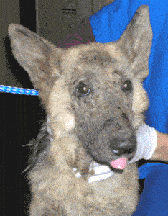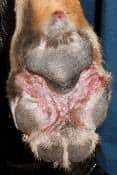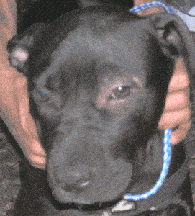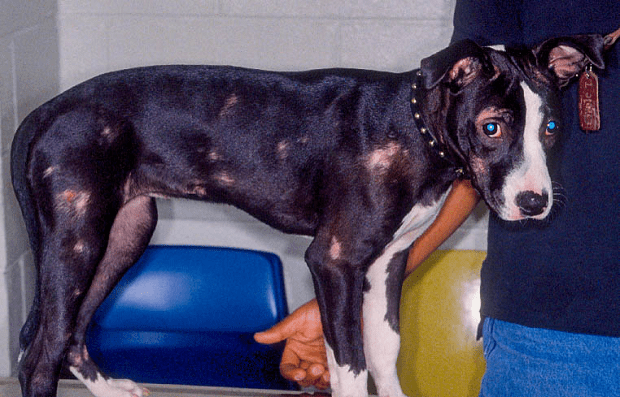The Cause is the mite – Demodex Canis
Demodectic mange, also called demodicosis, is caused by one of the microscopic mites of

the Demodex genus. Three species of Demodex mites have been identified in dogs: Demodex canis, Demodex gatoi, and Demodex injai. The most common mite of demodectic mange is Demodex canis. All dogs raised normally by their mothers possess this mite as mites are transferred from mother to pup via cuddling during the first few days of life. Most dogs live in harmony with their mites, never suffering any consequences from being parasitized. If, however, conditions change to upset the natural equilibrium (such as some kind of suppression of the dog’s immune system), the Demodex mites may gain the upper hand. The mites proliferate and can cause serious skin disease.
Is Demodicosis Contagious?
Unlike sarcoptic mange, demodectic mange is not considered a contagious disease and isolation of affected dogs is generally not considered necessary. That said, there are some circumstances under which the mites could spread from one dog to another. Classically Demodex mites have been felt to only be transferable from mother to newborn pup. After the pup is a week or so old, it has developed enough immunity so that infection is no longer possible. In other words, after age one week or so, a dog will not longer accept new mites on its body.
Recently this idea has been challenged as occasionally multiple unrelated dogs break with demodicosis in the same household. It is not clear if some species of Demodex are more contagious than others or if some contagion is possible under certain circumstances. Current thinking is that mites actually can be transferred from one dog to another but as long as the dog is healthy, the mites simply add into the dog’s natural mite population and no skin disease results. In rare circumstances contagion is possible if a very severe infection is involved. While there are still assorted theories about dog to dog transmission of Demodex mites, there is no question that mites cannot be transmitted to humans or to cats.
- Mites live inside hair follicles — a difficult place for miticides (chemicals that kill mites) to reach.
- Mites are normal residents of dog skin; it is only in some individual dogs that mites cause problems.
Demodicosis has Three Forms
Form #1: Localized
Localized demodicosis occurs as isolated scaly bald patches, usually on the dog’s face,

creating a polka-dot appearance. Localized demodicosis is considered a common puppyhood ailment and approximately 90% of cases resolve with no treatment of any kind. This is quite a contrast to generalized demodicosis as described below so it is important to be able to distinguish localized from generalized disease.
- Localized disease does not involve more than two body regions. (One spot or two on the face and one spot or two on a leg would still qualify as localized even though the spots are not close together.)
- Localized disease involves no more than four spots total on the dog.
Resolution of a localized demodicosis lesion should be at least partially apparent after one month though total resolution can take up to three months.
Approximately 10% of localized demodicosis cases will progress to generalized demodicosis. Enlarged lymph nodes are a bad sign — often foretelling generalized mange.
Can the Pup be Bred Later?
Sometimes the puppy with localized demodicosis was obtained for breeding purposes. The current recommendation is not to treat these puppies so that we can determine if the condition will stay localized and resolve or if it will generalize. If it stays localized and eventually resolves without treatment, the animal is still a candidate for breeding. If the condition generalizes to cover the entire body, the animal should be sterilized.
Localized demodicosis is almost exclusively a puppyhood disease. When a puppy develops localized demodicosis the chance of the condition resolving is 90% unless there is a family history of demodicosis in related dogs. In this case, chance of spontaneous resolution drops to 50%.
Occasionally an adult dog develops localized demodicosis. We currently do not have good understanding of the prognosis or significance of this condition in an adult dog. Often it may be tied to another underlying disease affecting immunity.
Form #2: Generalized
Classically, with generalized demodicosis, the entire dog is affected with patchy fur, skin

infections, bald, scaly skin. Sometimes large patches of affected skin are present, sometimes multiple polka dots of lesions cover the dog, and sometimes the entire body is involved. The secondary bacterial infections make this a very itchy and often smelly skin disease.
Adult onset – Most demodicosis occurs in young dogs, under age one and a half. An older dog should not get demodicosis unless he or she has an underlying problem with the immune system. In such cases, demodicosis is considered a indication to seek a more serious hidden condition such as cancer, liver or kidney disease, or an immune-suppressive hormone imbalance. A more extensive medical work-up will be required.
Juvenile Onset — Young dogs that develop demodicosis are believed to have a genetic immunological defect that allows the mite to gain the upper hand. As the puppy grows up and his immune system matures, the immune system tends to naturally regain control of their mite infestation; in fact, 30-50% of dogs under age one year recover spontaneously from generalized demodicosis without any form of treatment. Usually treatment is recommended, though, to facilitate recovery.
It is important that dogs with a history of generalized demodectic mange not be bred as there is a hereditary component to the disease.
Form #3: Demodectic Pododermatitis
In this condition demodectic mange is confined to the paws. Bacterial infectious usually

accompany this condition. Often as generalized demodicosis is treated, the foot is the last stronghold of the mite. Old English Sheepdogs and Shar pei tend to get severe forms of this condition. The infection can be so deep that biopsy is needed to find the mites and make the diagnosis. It is one of the most resistant forms of demodicosis and the deep infections and proliferative tissue that result can take months and great expense to resolve.
Treatment: Stress and Generalized Demodectic Mange
The treatment of demodicosis only in part relies on medications; some basic steps can be taken with regard to pet care to maximize the chance of success.
Physiological stress is an important factor determining the degree of severity of demodectic mange and the following steps should be taken to reduce stress:
- Females should be spayed as soon as the disease is controlled. Coming into heat, hormone fluxes, and pregnancy are stressful and will encourage the mites. Also, predisposition to demodicosis is hereditary and should not be passed on.
- The dog should be fed a reputable brand of dog food so as to avoid any nutritionally related problems.
- Keep the pet parasite free. Worms are irritants that the pet need not deal with and fleas may exacerbate the itchiness and skin infection.
- Keep up the dog’s vaccinations.
- The mites themselves cause suppression of the immune system so the pet needs every advantage to stay healthy.
- Skin infections are usually associated with these cases and antibiotics will likely be necessary. It is important that cortisone-type medications such as predisone NOT be used in these cases as they will tip the immune balance in favor of the mite.
Treatment: Medications
Current Treatment of Choice: Ivermectin
Ivermectin is a broad spectrum anti-parasite medication that is FDA-approved for the treatment of numerous parasite conditions. Its use in the treatment of demodicosis, however, is not FDA-approved. When ivermectin was a new drug, it was hoped that it could be used against demodectic mange mites as at that time only fairly toxic dips were available and incurable cases were common. After some experimentation it was found that daily or every other day dosing is necessary for effective demodicosis treatment and soon ivermectin was felt unequivocally to be the drug of choice for this condition. Note that the weekly protocols that work for other parasites simply do not work on Demodex mites.
This medication at the doses needed for mange cannot be assumed safe for use in collies, shetland sheepdogs, australian shepherds, old english sheepdogs and, some would say, any herding breed.
The doses of ivermectin used ito treat demodicosis are not compatible with the commonly used flea product spinosad (Comfortis® or Trifexis®). The combination of spinosad and high doses of ivermectin will increase the likelihood of ivermectin neurologic side effects. While flea control is important during treatment of demodectic mange, ideally an isoxazoline product should be used as these have additional effectiveness against Demodex mites (see below).
Another important caveat concerns heartworm. The high doses of ivermectin needed to kill Demodex mites will rapidly kill circulating larval heartworms in a heartworm-infected dog. The sudden death of a large number of worms in the bloodstream can lead to shock so, if the patient is old enough for a heartworm infection, it is important to verify that the patient is heartworm negative. Heartworm requires a good six to seven months to establish an infection, so younger puppies are not at risk for this reaction.
There is a range of ivermectin doses used in demodicosis treatment. It seems that higher doses clear infection faster than lower doses. This means that if a lower dose has been ineffective, a higher dose may still work. This does not mean that pet owners should experiment with ivermectin doses on their own as there is some potential for lethal toxicity if this drug is not used appropriately.
The Isoxazoline Flea/Tick Products (Bravecto®, Nexgard®, and Simparica®)
The isoxazoline products are oral medications labeled to kill fleas and ticks in dogs. It turns out they have substantial activity against Demodex mites and are successful enough that they may supplant ivermectin as the treatment of choice. They are also frequently combined with ivermectin for greater efficacy. These products are typically given orally every two to four weeks depending on the protocol. There is no issue with the MDR1 mutation with the isoxazoline products, which makes them particularly attractive for the herding breeds, though ivermectin still wins when it comes to expense.
Something else your Veterinarian Might Try:
Moxidectin (Advantage Multi®)
Dog Hospital in Houston Heights Area
Urban Animal Veterinary Hospital
1327 Yale St
Houston, TX 77008
(713) 863-008



